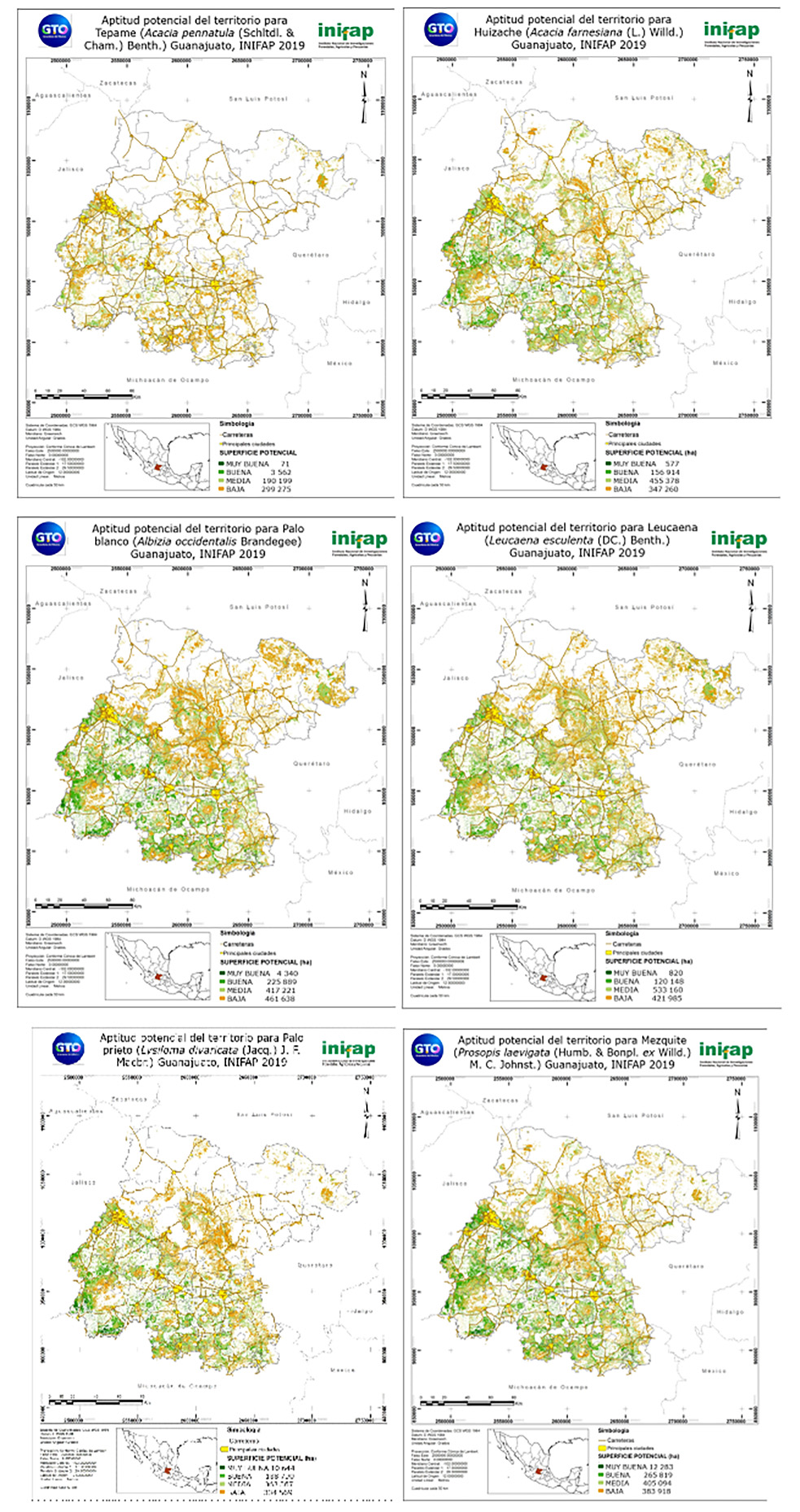Identificación de áreas potenciales para la reforestación con seis fabáceas arbóreas en Guanajuato
DOI:
https://doi.org/10.29298/rmcf.v14i80.1401Palabras clave:
Acacia pennatula, A. farmeciana, Albizia occidentalis, Leucaena esculenta, Lysiloma divaricata y Prosopis leavigata.Resumen
La pérdida y reducción de la cubierta forestal están relacionadas con la degradación del suelo y la disminución de servicios ambientales. Reforestar es un elemento clave para combatir el calentamiento global. Repoblar zonas deforestadas con especies forestales nativas aumenta la supervivencia y éxito de la plantación. Se planteó que de acuerdo con los requerimientos de altitud, pendiente, temperatura, precipitación, topografía, tipo, textura y profundidad del suelo y mediante el uso de la herramienta BIOCLIM es posible identificar y cuantificar las áreas potenciales de reforestación en el estado de Guanajuato para seis especies forestales de la familia Fabaceae. Con base en los requerimientos climáticos y edáficos, Prosopis laevigata fue el taxón con mayor superficie potencial para reforestar con 278 102 ha de aptitud buena y muy buena, Albizia occidentalis tuvo una superficie de 230 239 ha, para Acacia farnesiana (sinonimia de Vachellia farnesiana) se obtuvo un área de 157 491 ha, Lysiloma divaricata (sinonimia de Lysiloma divaricatum) de 149 434 ha, Leucaena esculenta de 120 968 ha, y en el caso de Acacia pennatula (sinonimia de Vachellia pennatula) se determinaron solamente 3 633 ha. Las áreas delimitadas son las zonas donde es posible plantar estas especies y garantizar mayor probabilidad de supervivencia y éxito en trabajos de reforestación, y con ello la restauración del paisaje.
Descargas

Descargas
Publicado
Cómo citar
Número
Sección
Licencia
Derechos de autor 2023 Revista Mexicana de Ciencias Forestales

Esta obra está bajo una licencia internacional Creative Commons Atribución-NoComercial 4.0.
Los autores que publiquen en la Revista Mexicana de Ciencias Forestales aceptan las siguientes condiciones:
De acuerdo con la legislación de derechos de autor, la Revista Mexicana de Ciencias Forestales reconoce y respeta el derecho moral de los autores, así como la titularidad del derecho patrimonial, el cual será cedido a la revista para su difusión en acceso abierto.
Todos los textos publicados por la Revista Mexicana de Ciencias Forestales –sin excepción– se distribuyen amparados bajo la licenciaCreative Commons 4.0 Atribución-No Comercial (CC BY-NC 4.0 Internacional), que permite a terceros utilizar lo publicado siempre que mencionen la autoría del trabajo y a la primera publicación en esta revista. (no permite el uso comercial)
Los autores pueden realizar otros acuerdos contractuales independientes y adicionales para la distribución no exclusiva de la versión del artículo publicado en la Revista Mexicana de Ciencias Forestales (por ejemplo, incluirlo en un repositorio institucional o darlo a conocer en otros medios en papel o electrónicos) siempre que indique clara y explícitamente que el trabajo se publicó por primera vez en la Revista Mexicana de Ciencias Forestales.
Para todo lo anterior, los autores deben remitir el formato de carta-cesión de la propiedad de los derechos de la primera publicación debidamente requisitado y firmado por los autores/as. Este formato debe ser remitido en archivo PDF al correo: editorial.forestal@inifap.gob.mx
Esta obra está bajo una licencia de Creative Commons Reconocimiento-No Comercial 4.0 Internacional.





